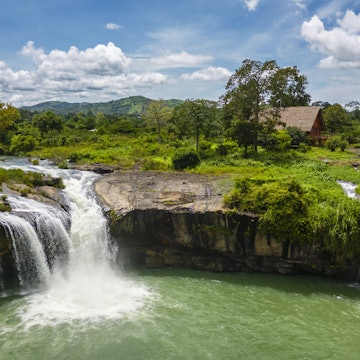
Islands, temples and caves: 7 great day trips from Hoi An

Jun 21, 2019 • 4 min read

A giant concrete hand holds up the Golden Bridge in the Ba Na Hills. Wichiandungsri / Getty Images
You’ve explored the Unesco-heritage centre of Hoi An, spent some time on An Bang beach, seen plenty of arts and crafts, and the new clothes you ordered at one of the town’s many tailors will be ready any day. While you wait, though, there’s lots to see beyond the Old Town. Here are some great day trips to take from Hoi An.
Explore the Citadel in Hue
Hue (pronounces ‘hway’), located on the Perfume River, was the capital of the Nguyen emperors from 1802 to 1945. Many of its fine buildings were destroyed during the American War, but the 19th-century Citadel and a lot of temples and tombs are still there to explore. Visit the Imperial Enclosure and Forbidden Purple City within the Citadel, although beware that some of it is still being reconstructed.
Getting there: Hue is nearly a three hour drive from Hoi An. Either hire a driver for a full day tour, or book on a group tour in Hoi An.
Dive or snorkel around the Cham Islands
The Cham Islands are around 15km offshore of Hoi An and make for a perfect day trip. The granite islands are a playground for divers, snorkellers and beach-goers. Visit between March and September when the ocean isn’t too rough. There’s good swimming on Bac Beach; the only other sight is a temple dedicated to whales, which are sadly seldom seen around the islands.
Getting there: The islands are reached by local ferry or high-speed boat. Alternatively go as part of a snorkelling or dive group with one of the local dive schools, such as Cham Island Diving.

Visit the temple ruins in the jungle at My Son
My Son (pronounced ‘me sun’) is the site of Vietnam’s most extensive Cham remains and traces its history back to the late 4th century. The Hindu temples, mostly in ruins, are set in lush jungle overlooked by Cat’s Tooth Mountain. The ruins were rediscovered in the 19th century and parts of the complex were restored, but during the American War, important monuments and structures were further destroyed, particularly the ‘Group A’ temples. The ruins can get very busy, so it’s worth going early to avoid both the crowds and the heat.
Getting there: My Son is 55km from Hoi An and well signposted. If you don’t have your own vehicle, hire a driver in Hoi An, or ask your accommodation to book you on a minibus tour.
Take the cable car to the Golden Bridge near Danang
The Golden Bridge in Ba Na Hills opened in June 2018 and was an instant Instagram hit. It’s part of Sun World amusement park (entrance fee: 750,000 VND), reached by a 5km-long cable car ride into the mountains. Views over the jungle down into the city of Danang are spectacular. Take another cable car from the bridge up into the French town that’s the centre of the theme park. From there, head down into Danang, which is approximately an hour’s drive; you can sample some local beers, or simply relax on the beach.
Getting there: Sun World is around 60km from Hoi An, and the drive takes about two hours. Guided tours are available, but are likely to be more expensive than hiring your own driver.
See the caves and shrines in the Marble Mountains
The Marble Mountains (Ngu Hanh Son) are made up of five marble outcrops, each one topped by a pagoda. The mountains are said to represent the elements and are named accordingly: Thuy Son (Water), Moc Son (Wood), Hoa Son (Fire), Kim Son (Metal or Gold) and Tho Son (Earth). The atmospheric network of caves through the mountains are worth exploring. In addition to chimney-like formations and stalactites, expect to see Hindhu and Buddhist altars, shrines and inscriptions carved on cave walls. Parts of the cave network were used by the VC as a field hospital during the American War. Stop by the villages at the foot of the mountains where artisans sell marble sculptures.
Getting there: Group tours depart Hoi An, or, if you have your own vehicle, look for the turning off the Danang Beach coastal road. It’s about a half-hour drive from Hoi An.
Visit the Co Tu in Bho Hoong
The Co Tu people are a small and traditional minority group in Vietnam. Villages are made up of stilt houses organised around a central community building, which is used for meetings, performances and rituals. The village of Bho Hoong, in the inland mountains, has a community tourism project that welcomes visitors to the settlement, providing overnight accommodation in modern, comfortable thatch bungalows.
Getting there: Various tour operators run trips from Hoi An, often including tours of the countryside all the way to the Laos border. Visitors can arrange independent visits, but be sure to book accommodation in advance. Bho Hoong is just over a two-hour drive from Hoi An.
Keep it local with a short trip to Thanh Ha
The village of Thanh Ha is known for its pottery industry. For a small admission fee, you can visit the artisans, who are happy to show you their work (and usually much happier if you buy some of it). It’s unlikely that you’ll want to spend a full day here, but it’s certainly worth a trip.
Getting there: Thanh Ha is only 5km from Hoi An and can be reached by bike.
Get more travel inspiration, tips and exclusive offers sent straight to your inbox with our weekly newsletter.
https://shop.lonelyplanet.com/products/vietnam-travel-guide-14















